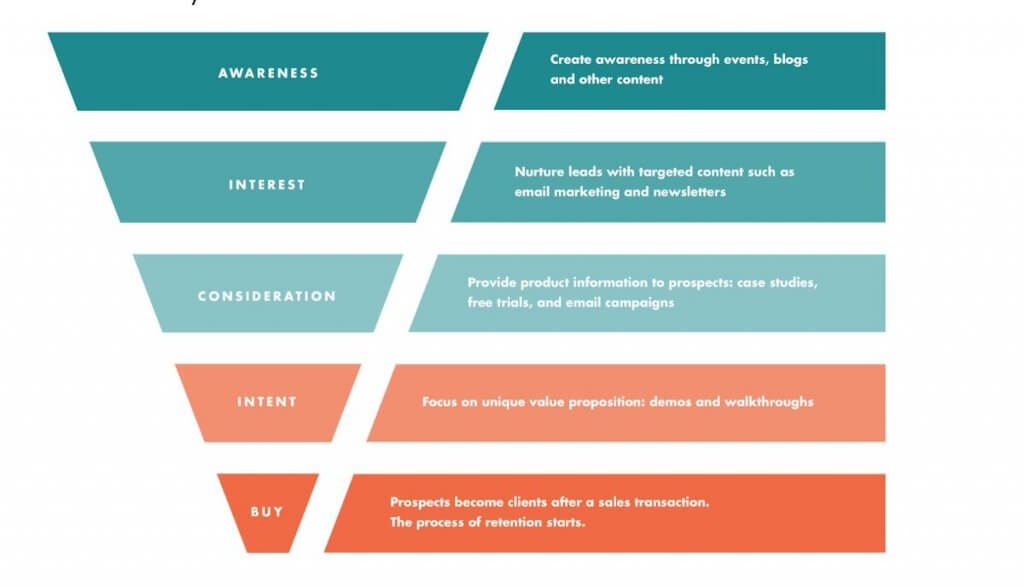Wondering what more you can do to make more affiliate sales? One thing for sure is to create great content that will help you drive more affiliate traffic and convince more people to buy. And what content is that? Take a look at some examples and tips below.
So, why do you need content for affiliate marketing?
Let’s take a look at how affiliate marketing works first. (You can also check out this post on how to get started with affiliate marketing and another one on affiliate marketing examples.)
As an affiliate marketer, you help promote a brand. Let’s say it’s the NapoleonCat platform, so you want to encourage people to sign up for an account. Every time they do, you get a commission, either from their annual payment or the monthly payments they make across their first year.
But how do you get them to sign up? Well, you’re definitely not going to walk around the neighborhood putting up posters on every tree. But there are some things you need to prepare first. (Yes, it’s passive income, but it’s not like you can be entirely passive, and money will just flow regardless.)
You need an online audience that’s potentially interested in buying an account (so, most likely marketers, small business owners, content creators, etc.) And that’s the audience reading your blog, following your social media channels, or maybe subscribing to your newsletter (or all of the above.)
Of course, you can just keep posting ads or your affiliate link with “Buy Now” calls to action. But if that’s all you have to offer, this tactic will quickly stop working (if it ever works at all.)
And that’s when you need content marketing:
- To build relationships with your audience based on trust, using your expertise on the subject (and not just empty sales slogans);
- To educate people on the different ways they could benefit using the promoted product or service;
- To provide helpful tips and advice that’ll help them succeed using it. Especially with a subscription-based product, the longer they use it, the more commissions you make, so it’s really in your interest to find the right customers and help them benefit from the solution (not to mention it’s just a decent thing to do).
- To help others find your content (for example, through Google) and increase your reach. And as a result, get more affiliate traffic and sales.
How to create content for affiliate marketing
Why is content important to affiliate marketing? Well, for the same reason, it’s important to marketing overall.
The role of content marketing is really to help your audience make the right choice for them, based on the information you provide at the stage of the customer journey they’re currently at.
Here’s a straightforward visual representation of the buyer journey stages (or what marketers also call a sales funnel) and relevant content types taken from Marketing Insider Group (go to the link to read the entire post by Michael Brenner):

Looking at creating content from this perspective is super helpful for the overall affiliate marketing content strategy.
So if customers are at the bottom of the funnel – researching social media management platforms to sign up for (sticking to the NapoleonCat example) – what they’ll need is, for example:
- A case study showing a success story of another customer,
- A comparison article showing the benefits of the platform over others,
- Or a special offer with a discount.
But if they’re at the top of the funnel, they might not yet be familiar with the platform at all, or maybe even with how to use a social media management platform in their work. So the job of the content you put out there for those people should be more educational – perhaps:
- A how-to article,
- A series of educational videos or emails,
- Or a guide on managing social media for business.
The whole point is to know your audience and what they need – and then create content that answers those needs. It’s how you can make your affiliate marketing efforts much more effective.
And how do you do it?
The best way is to ask. 🙂 You can do it on your social media channels or send a survey to your email list. That way, you’ll know what content (and type of content) will resonate with them.
And then, start creating! Depending on your niche and your audience preferences, this could be:
- Blog articles
- Ebooks
- Videos
- Social media posts
- Newsletters
- TikToks or Instagram Reels
- And, of course, a mix of different types of content for people at different stages of their customer journey.
I know, I just made it look easier than it is. So let’s unpack this a little more and look at some affiliate marketing content ideas.
15 types of content for your affiliate marketing
1. Product reviews
Product reviews are the most obvious choice – especially if you’re using the product you recommend yourself (which, btw, is always a good idea.) An honest, authentic review is something people will appreciate. And if you’ve already built trust with your audience, they’re probably more likely to act on it than on the brand’s communication alone.
Don’t forget to include your actual experiences with the product or service you recommend, plus also focus on the features and characteristics they’ll find helpful. (And, again, if you’re not sure what they are, ask them.)
You can post the review on your blog and promote it on your social media channels or in your emails – whatever channel you use to communicate with your audience.
Pro tip: Doing some SEO research and including the most searched keywords and phrases in your review will help you target new audiences of people who are looking for more details about that particular promoted product or service (giving you an opportunity to grow your affiliate sales with time).
2. Product comparisons
Another variant of the above is articles comparing similar products – their features, prices, and user benefits. As mentioned before, this is also helpful for the people who are already contemplating buying a product like the one you promote and might need a little bit of extra info from a third party to make their purchase decision.
The thing with product comparisons is that you can actually include several affiliate links – if you decide to promote more than one product in a given category (or sign up for several affiliate programs). Which means you don’t have to point to one product as the winner. Instead, you can talk about the benefits of the different products for different needs and business types.
Same SEO tips apply!
3. Product roundups
Product roundups are similar to product comparisons in that they include several affiliate products across a given category or theme. But instead of comparing products to one another, you can recommend different brands for different purposes or include complementary products.
One example I can think of right now if I promoted NapoleonCat would be something like “X marketing tools that help save time.”
A product roundup could also be a gift guide or a “top 10” list in a given category. You get the idea.
And here’s how to create a marketing gift guide with examples.
4. Tutorials
The product or service you’re affiliated with might have a library of their own help resources and tutorials (like NapoleonCat does). But creating your own is also a good idea, even if that’s the case.
For one, if you have an engaged audience of people who trust your recommendations, they’ll probably be more likely to follow your advice than a brand they might not know yet. And second of all, you again let yourself be found by people who specifically search for content related to a specific tool. And maybe they want an opinion from someone who actually uses it and can tell them something more about it?
Apart from just the features, try adding your own story or something that will be relevant specifically to your target audience (that they might not find in the original tutorials.) This might be the element that will actually encourage people to hit the “buy” button eventually.
5. Videos
The tutorials can, of course, be videos – for example, on your YouTube channel. And so can be the product reviews and walkthroughs. But really, the format and contents of your videos is something you and your target audience should decide on.
If you’re already known for a type of content (like, e.g., if you have a YouTube channel where you review products in a specific category, such as marketing software, online games, or beauty products), the best idea is to seamlessly include your affiliate links in one of them.
A good practice is to track your content performance and choose a format that gets the most views and is also likely to get you higher conversion rates.
Pro tip: Be honest with your audience about the affiliate program you take part in. It’s not like you want to trick them into buying something they don’t need, right? 😉 And if they turn out to need it, they might as well let you profit from the recommendation (especially if they value your content anyway).
6. Emails
If you have an active and engaged email list, emails can be a great place to promote your affiliate brand. You can do it in different ways:
- Send an educational series over time to present the various features of the product
- Add your affiliate link to a section present in all the emails you send to your audience
- Promote your content published in other channels in your emails.
And if you don’t have an email list yet, affiliate marketing can be a great reason to start building one with a signup form posted on your blog or website and promoted across your other channels.
You can even add your affiliate link in the footer of your work or personal emails if you know people from your network might be interested in using the product you promote. (It’s like the email version of “link in bio.”)
7. Ebooks
Ebooks definitely require more effort to create, as they’re usually longer than a straightforward blog post. But once you do create one, you’ll get yourself some (hopefully) evergreen content that you can keep profiting from for a very long time.
So start by defining the topic – again, based on what your target audience is interested in, and also – preferably – on what you’re an expert at. Coming back to the NapoleonCat example, if you’re a B2B marketer, you can write an ebook about:
- The different tactics for building an audience
- Or providing customer service on social media.
Or, if you’re a beauty influencer, you can write an ebook around any beauty topic you specialize in.
And you can either promote one product or service in the ebook or, again, use many affiliate links for more sales opportunities (same rules apply re: transparency and authenticity.)
Consider using the ebook as an opportunity to also build your email list – you can ask people for their email addresses in exchange for the download. (But that only makes sense if you’re actually planning on using email marketing later.)
Email marketing platforms will usually let you build a simple signup page with a download form, often using ready-made templates, so you can pretty quickly assemble your own marketing funnel. Here are some examples.
8. Landing pages
A dedicated landing page is also an excellent idea to promote a product or service. You can use it to present the benefits and link to signup/product purchase via your affiliate link. Direct people to it from your emails, ads, or social media posts to have the chance to present them with more information and maybe convince them to buy.
The landing page can also offer your ebook download, include a video, etc. Just make sure the page has one goal and doesn’t link to too many other pages or resources not to distract the reader too much.
Here are some solid best practices for writing landing page copy. And you can create a simple landing page with most email marketing and marketing automation platforms, so be sure to check those out. (No affiliate links included here. ;))
9. Case studies
Case studies are a super-effective way to present the benefits of a product or service – especially further down the sales funnel, where people are seriously considering their options.
A case study can be a dedicated landing page or a post on your blog – or even a video on your YouTube channel. The critical thing with case studies is to provide as much specific information about the benefits of the solution you promote as possible. This makes it more relatable and definitely more convincing.
A good idea is to present your own case study – if you’re using the product yourself and have seen good results.
And speaking of results, they’re crucial in a case study. So make sure you:
- Describe the challenge,
- Present the solution (the product),
- And then follow up with tangible results to really make the content compelling.
Here are some case study examples and templates.
10. Social media posts
Social media is an excellent place for your affiliate marketing content – assuming you’ve built an engaged following (doesn’t have to be huge) and have a larger idea for long-term engagement. Affiliate marketing can be a great way to monetize Instagram or other social channels you already use.
Because, you know, just posting your bare affiliate link every now and again probably won’t work. So think of ways to engage your audience around the product you want to promote – including any of the above-mentioned types of content, like case studies, tutorials, etc.
And again, if you’re already known for specific content formats, you can include your affiliate promo in them and think of ways to use what already works for your audience and what they’re already used to.
And if you struggle with planning your social media content, try using a scheduling calendar (like NapoleonCat – again, not an affiliate link. We’re on NapoleonCat’s blog, remember?) to plan out content ahead of time.
11. Resource pages
If you run a blog or a website, creating resource pages with helpful links and content is also worth it. Depending on your industry and niche, this can be anything from content for marketers to beauty product recommendations, etc.
A resource page – sometimes called a pillar page – gathers all important information and content on your website (and other websites) around a specific topic. And it can be a good place for your affiliate marketing content next to all the educational articles and videos you’ve already created.
Google also seems to favor this kind of in-depth treatment of a topic (provided, again, you’ll use the right keywords to help people find it).
12. How-to articles
Practical, valuable articles on your blog providing readers with “x ways” to do something are also what you can use for your affiliate content.
Some ideas could be:
- Articles showing people how to do a specific task using the product or service. So, for example,
“How to automate social media management with NapoleonCat”
or
“How to contour your face with XYZ.”
Or,
“How to write a how-to article.” 🙂
- More general educational topics showing people how to achieve specific goals and mentioning the affiliate product (or products) inside. Like, e.g.,
“How to provide better customer service on social media”
or
“How to apply sunscreen to prevent aging”
You know, that kind of stuff.
Again, promote them on social media or in your emails and make them easily searchable with the right set of keywords. And don’t forget, you can have the best content out there, but you won’t make any affiliate sales if nobody sees it.
13. Guides
Similar to how-to articles, guides can educate people in a specific area but more comprehensively. And, again, depending on what you promote, the guide should show them, step by step, how to achieve it.
It can come in the form of a longer article or a downloadable ebook, for example. And, as the name suggests, it can guide your reader through a particular topic, including showing specific products, tools, etc. (enter affiliate links.)
Want some ideas?
- “A guide to a better social media customer service” (if you promote a tool like NapoleonCat)
- “Dry skin care – a guide” (for promoting beauty and skin care products)
- “Losing weight without starving yourself – a guide” (for a gym chain or a nutrition expert)
Guides can also include gift ideas, holiday tips, or an in-depth look into a product or a selection of products for a “buyer’s guide” – helpful for those of your readers that are really close to purchasing but need some, well, guidance from someone who’s been there.
As a guide will typically be longer, you need to research your topic well (helps if you’re an expert yourself) and provide any credible industry data, best practices, etc. You can also collect user reviews or expert opinions and include all of them inside for a really comprehensive, helpful piece.
…And here’s a guide on writing a guide, if you know what I mean.
14. Listicles
You know, kind of like this one. 🙂 Listicles – as the name suggests – are articles providing helpful lists, usually of products or services in a specific market category.
So just as you’re reading a list of affiliate content types (though not really affiliated with anything other than NapoleonCat), you can create lists of:
- Software platforms (e.g., email marketing platforms, social media management platforms, online meeting tools, etc.)
- Best skin care products for certain skin types or needs (like “20 best 50+ SPF creams for demanding skin”)
- 20 holiday ideas that won’t break the bank.
And so on and so forth.
The benefit of listicles is that you can add multiple affiliate links depending on the number of affiliate programs you take part in.
Pro tip: What I personally suggest is including a personal insight instead of just aggregating products and their generic descriptions. The Internet is full of listicles, so if you want to stand out and provide actual value to your readers (which also means making it more likely for them to act and buy), find a way to present them that goes beyond the generic stuff and relates to what your readers might really be looking for.
15. Seasonal content
This is precisely that – content you create for different sales holidays and times of year that includes the product/service you promote.
An example I’ve already mentioned is a gift guide – for Mother’s Day, Christmas, and any other relevant occasion.
And if the brand you collaborate with has seasonal discounts, e.g., for Black Friday, you can also create social media posts, video content, or emails to notify your audience and encourage them to buy (using your affiliate links, of course).
The range of seasonal content will, of course, depend on the product and your target audience, so check the calendar ahead of time to know when’s a good opportunity to publish something people will be looking for (like when they’re actually searching for a Mother’s Day gift). And make finding it a little easier (making some affiliate money while you’re at it.)
So, what affiliate content will you create?
As you can see, there’s a whole variety of options you can go for to support your affiliate marketing sales with relevant content. Whatever you do, though, consider the resources you have to create it and your audience’s needs. It’s like with any other type of marketing – you can’t really sell people stuff they don’t want or need.
So do audience research first to choose your affiliate program (here’s a post on the best affiliate programs to join) and then create content people will actually want to read (and buy things from).
Good luck!
You may also like:
- Gain extra revenue streams with the affiliate program
- Affiliate Marketing 101: How to Get Paid
- Affiliate Marketing Myths (and the real truth behind them)
- Best Affiliate Marketing Examples to Help You Make Money While Sleeping
- Best Affiliate Programs
- How to Promote Affiliate Links
- Why Do You Need an Affiliate Marketing Funnel, and How to Build One
- 15 Best Affiliate Marketing Tools
- All You Need to Know About TikTok Affiliate Marketing
- How to Plan Your TikTok Affiliate Marketing Strategy Around Black Friday and The Holiday Season
- Affiliate Marketing Taxes: Everything You Need to Know





